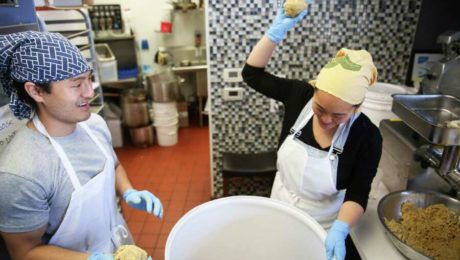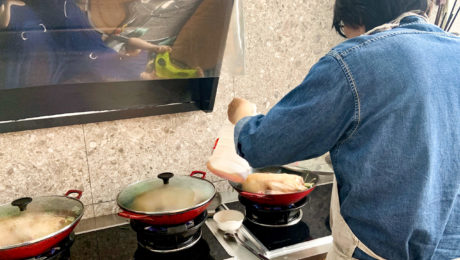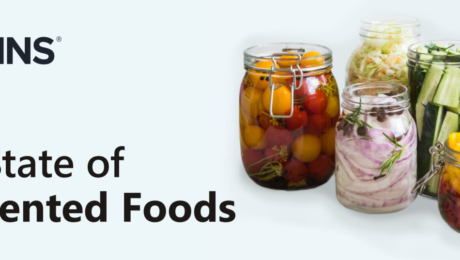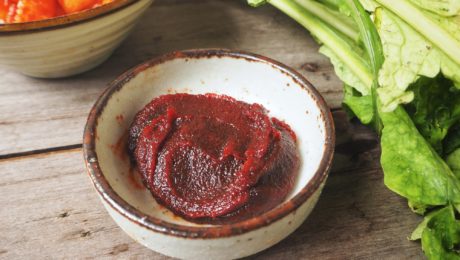Chef’s Secret: Fermented Bean Curd
Chef Andrew Wong created the first Michelin two-star Chinese restaurant outside Asia. His London-based A Wong is an homage to China’s 3,000-year culinary history and a contemporary spin on the country’s regional cuisine.
Fermented wild sea bass and fermented coconut are part of the “Taste of China” dinner menu. A popular dish called “Why the Buddha Didn’t Jump Over the Wall” is barbecued sweet potato covered in a fermented, salted black-bean relish. It’s no surprise Wong’s favorite ingredient is fermented bean curd. He says the tofu, soaked in salt and chili, is as close to cheese as you can get in China. It’s eaten with congee and used as a condiment.
“It’s very salty; umami in its purest form,” Wong says. “I use it a lot in my cooking, especially in vegetarian dishes where we can’t use oyster sauce. We cook it out with some stock, ginger, garlic, and make a sauce. The combination of vegetables, garlic, chili and fermented bean curd creates a really deep meaty flavor.”
He advises chefs to use it like a stock cube, because it’s soft and will coat the mouth in umami flavor.
Read more (Guardian)
- Published in Food & Flavor
Scaling Artisanal Fermentation
Fungi fermenter Shared Cultures was the featured cover story in a recent Food & Wine section of the San Francisco Chronicle. Company co-owners Elena Hsu and Kevin Gondo make small-batch fermented soy sauce, miso, and sauces and marinades using koji and wild, foraged mushrooms.
The article calls Shared Cultures “the darling of the Bay Area food scene.” It details how they use traditional techniques with unexpected ingredients, like a shoyu with quinoa and lentils, a miso with cacao nib and a koji salt with leek flowers.
Hsu and Gondo also open up about the challenges of scaling artisanal fermentation. They are the only employees at the companys and can’t keep up with the demand. Their ferments require a lot of time, some fermenting for eight months in a closet-size room in their rented commercial kitchen. They note that it is too expensive to rent or purchase their own warehouse in the Bay Area.
Multiple California chefs use Shared Cultures products for an added umami punch. Hsu encourages home cooks to experiment with their products, too, “You don’t have to have a $300 tasting menu to try these flavors,” she says. “You can be the chef.”
Read more (San Francisco Chronicle)
- Published in Business, Food & Flavor
The Ancient Origins of Japanese Soy Sauce
Soy sauce is arguably the most important seasoning in Japanese cooking. Its well-balanced, salty-sweet taste and deep layer of umami richness make nearly all foods taste more delicious and satisfying. Its uses range from a dab on sushi to a splash into noodle soups and stir-fries, as well as the featured flavor of glazed dishes like teriyaki,” reads an article in BBC Travel.
The author traveled to the port town of Yuasa to learn more about the history of the “holy grail of Japanese cuisine: soy sauce.” In 2017, the country’s Agency for Cultural Affairs designated Yuasa as a Japan Heritage Site for being the birthplace of Japanese soy sauce. Soy sauce was first made in Yuasa in the 13th Century.
At its peak, the small town with a population of around 1,000 had more than 90 soy sauce breweries. Today, there are five soy sauce shops and six Kinzanji-miso makers. The decline is related to the rise of mass-produced soy sauce brands, who skimp on quality for a lower-priced soy sauce. It’s estimated that only 1% of soy sauce brewers still produce using traditional methods.
Read more (BBC)
- Published in Food & Flavor
China’s Secret Sauce
NPR highlights “Lu, the secret sauce at the heart of many Chinese family cuisines.” Every Chinese region uses a variation of Lu in their cuisine. It is made from a base of salty liquid (like soy sauce) mixed with sugar and spices. But salt is core to the product, more so than the spices.
Lu takes on “the characteristics of each of China’s regional cuisines.” In Sichuan, Lu is spicy; in Zao, it is alcoholic, made from the fermented rice left over from brewing Chinese yellow wine.
One Chinese restaurant chef (pictured, who asked NPR to keep him anonymous so his restaurant stays out of the limelight) traces his Lu sauce to “an unbroken chain of sauces dating back to that first batch his mother made in the 1980s.” The chef takes his sauce at the end of each day and gives it “nutrients” – fresh spices and meat boiled in Lu.
“It is a bit like sourdough, where the last batch seeds the next batch, and the flavor intensifies over the years,” the piece continues.
Read more (NPR)
- Published in Food & Flavor
Asian American Entrepreneurs React to Online Trolls
Racist and sexist comments have long been hurled at food companies run by Asian American women. But in the modern tech era, where food brands have a social media presence, these cruel remarks from trolls are being dealt with in a variety of ways. Some fight back with humor, others aim to educate while some ignore it.
Kim Pham, co-founder (with her sister Vanessa) of Omsom (which sells Asian pantry staples), said it was difficult in the brand’s early days for her to read offensive comments. She came to a sad realization: “I think it’s par for the course when you are an outspoken brand run by women of color.”
“For so long our community has been defined by this model minority myth, of being quiet, or docile, or submissive,” said Pham, “and we really just wanted to give a middle finger to that.”
Omsom’s social media policy is to remove insulting comments, but leave anything that “might generate a fruitful conversation.”
Jing Gao of Fly By Jing (which sells Asian pantry staples, dumplings and hot pots) (pictured), though, takes a different approach. “We have no problem making fun of those people who are, you know, clearly disturbed,” said Jing Gao, the company’s 34-year-old founder, adding “We definitely troll them. … and our community seems to really love it.”
Meanwhile Sahra Nguyen, founder of Nguyen Coffee Supply, has zero tolerance for trolls. She doesn’t want her employees engaging in toxic behavior, so they don’t respond.
Read more (The New York Times)
- Published in Business
From Chemist to Fermenter
Four years ago, Bob Florence, 62, made a radical turn in his decades-long career as an industrial chemist. With the help of his wife Debbi Michiko Florence and business partner James Wayman, he began making small batch soy sauce, miso and other condiments under the brand name Moromi (Japanese for “mash”) Artisanal Shoyu.
Florence always enjoyed cooking, but making soy sauce (shoyu) piqued his interest. “It’s technically really super challenging,” he says. The different types of soybeans, wheat, salt and koji that can be used to create different varieties were especially appealing. Florence trained in Japan with the president of Chiba Shoyu, Kyosuke Iida.
Florence’s partners bring their own skills and perspectives to Moromi. Wayman, a chef at Nana’s Bakery and Pizza and Grass and Bone Butcher Shop in Connecticut, focuses on using local ingredients, some of which he forages. Michiko Florence, a third-generation Japanese American, is a children’s book author who has made food and Japanese culture features of her books.
Read more (The Day)
- Published in Food & Flavor
Retail Sales Trends for Fermented Products
Miso, frozen yogurt and pickled and fermented vegetables are driving growth in the $10.97 billion fermented food and beverage category. The fermented products space grew 3.3% in 2021, outpacing the 2.1% growth achieved by natural products overall.
“It really highlights how functional products have become the norm for shoppers when they’re in stores,” says Brittany Moore, Data Product Manager for Product Intelligence at SPINS LLC, a data provider for natural, organic and specialty products. Moore notes there’s an “explosion of functional products” in the market — “[they] are appearing everywhere. And fermented products have been leading that space in the natural market for years.”
The data was shared during TFA’s conference, FERMENTATION 2021. SPINS worked with TFA to drill into data covering 10 fermented product categories and 64 product types (an increase from last year). [A note that wine, beer and cheese sales are excluded from the data. These categories are very large, and would obscure trends in smaller segments. Wine, beer and cheese are also well-represented by other organizations.]
Yogurt dominates the fermented food and beverage landscape with 75% of the market, but sales growth is soft. Frozen yogurt and plant-based offerings, though small portions of the yogurt category, are fueling what growth there is. “Novelty products are catching shopper’s eyes,” Moore notes.
Kombucha, the fermented tea which led the U.S. retail revival of fermented products, still rules the non-alcoholic fermented beverages market, with 86% of sales. But growth is slowing. Moore points out that this slowdown is due to kombucha having penetrated the mass market with lots of brands on grocery shelves.
“There’s opportunity in kombucha for new innovations to catch the progressive shopper’s eye,” Moore says. “Shoppers are looking for an innovative twist to their functional product.”
Moore points to successful twists like hard kombucha, which grew nearly 60%, and probiotic sodas, which grew 31%.
Growth is slowing for hard cider, too, though hard cider leads the alcoholic beverages category with 83% share of sales.
All sectors of the pickled and fermented vegetables category are growing, totalling nearly $563 million in sales. Refrigerated products are nine of the top 10 subcategories here. The “other” pickled vegetable subcategory is increasing at a 60% growth rate, “other” being the catch-all for vegetables that are not cucumbers, cabbage, carrots, tomatoes, beets or ginger. Fermented radish, garlic and seaweed fall into this subcategory.
Soy sauce is not surprisingly still the largest product in sauces, representing 58% of the category. But that share is dropping. Gochujang is the growth leader, increasing at rate of nearly 20%.
Miso and tempeh are also performing well, which Moore attributes to the growing plant-based movement and the Covid-19 pandemic pantry stocking boom. Miso products — soups, broths, pastes and mixes — totaled over $24 million in sales in 2021. Though instant soups and meal cups represented only 8% of sales, they grew more than 110%.
- Published in Business
The Gochujang Debate
The next “it” condiment in the U.S, gochujang is sweet and spicy, fermented for six to 12 months, and adding an umami tang. More restaurants are incorporating gochujang into their dishes, like the Shake Shack chain has done with their new Korean-Style Fried Chick’n sandwich.
But gochujang’s popularity has been a divisive issue. On one hand, many critics say mainstream food culture shouldn’t cherry-pick trends. “Ethnic foods, particularly the fermented variety, have a history of being typecast as unappetizing in the United States,” writes Hanna Park, the article author. She quotes Eric Kim, a food writer for The New York Times who says he hates that gochujang is now popular: “I never like to say a pantry ingredient is ‘trending’ or ‘mainstream,’ because that implies it is new. But new to whom? Gochujang is one of the oldest foodstuffs, beloved by millions of people for centuries.”
Meanwhile, other food experts say it’s wonderful to see Korean food used as inspiration for new dishes. Chef Hooni Kim, who owns Danji and Hanjan restaurants in New York City, says there was a time when Americans didn’t know anything about Korea, confusing it with China and Japan. Gochujang helps people appreciate Korea for its food culture. “It all comes down to execution. If they make it delicious, so people like Korean fried chicken or gochujang, then I thank them,” he said.
Read more (NBC News)
- Published in Food & Flavor
The Dodo of Gastronomic History
Scientists are working to recreate an ancient garum, considered the “dodo of gastronomic history.” Beloved by Mediterranean civilizations, the fish sauce was thought by historians to be extinct, lost along with the Roman Empire.
Food technicians got new insight into this garum when archaeologists discovered sealed dolia (large clay storage vessels) at what is believed to be a former Garum Shop at Pompeii. The eruption of Mount Vesuvius buried the building, preserving the factory. The charred, powdered remains left in the vessels — plus a fish sauce recipe believed to have been from the 3rd century A.D. — has aided food techs in recreating the ancient garum.
This product uses heavily salted small fish fermented for one week with dill, coriander, fennel and other dried herbs in a closed vessel. The resulting “Flor de Garum” is sold in Spain by the Matiz brand in amphora-shaped glass bottles.
Top chefs in Spain have been using Flor de Garum in new dishes. Mario Jiménez Córdoba, chef at El Faro in Cádiz, uses it in black-truffle ice cream, a raw sea bass dish and chocolate ganache.
“When people think of garum,” Jiménez says, “they imagine something that smells disgusting. But we have to think of garum like we would salt, or soy sauce. You use only a few drops, and the flavor is incredible.”
Read more (Smithsonian Magazine)
- Published in Food & Flavor, Science










